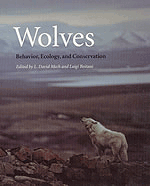"Wolves is an indispensable compendium on all biological aspects of these endlessly absorbing carnivores. With great authority the authors have opened our minds to the richness of wolf behavior and adaptability.…Directly and indirectly Wolves offers a powerful statement about the moral obligation of everyone to help these symbols of wildness endure."—George B. Schaller
Elsewhere on the web:
The International Wolf Center in Minnesota
Wolf Haven International in Washington
The Gray Wolf website from Alberta
The Wolf Trust in the UK
Wolves
Behavior, Ecology, and Conservation
Edited by L. David Mech and Luigi Boitani
L. David Mech and Luigi Boitani
The wolf is truly a special animal. As the most widely distributed of all land mammals, the wolf, formally the gray wolf (Canis lupus), is also one of the most adaptable. It inhabits all the vegetation types of the Northern Hemisphere and preys on all the large mammals living there. It also feeds on all the other animals in its environment, scavenges, and can even eat fruits and berries. Wolves frequent forests and prairies, tundra, barren ground, mountains, deserts, and swamps. Some wolves even visit large cities, and, of course, the wolf's domesticated version, the dog, thrives in urban environments.
Such a ubiquitous creature must, as a species, be able to tolerate a wide range of environmental conditions, such as temperatures from -56° to +50°C (-70° to +120°F). To capture its food in the variety of habitats, topographies, and climates it frequents, the wolf must be able to run, climb, lope, and swim, and it performs all these functions well. It can travel more than 72 km (43 mi)/day, run at 56-64 km (34-38 mi)/hr, and swim as far as 13 km (8 mi) (P. C. Paquet, personal communication), no doubt aided by the webs between its toes.
The wolf leads a feast-or-famine existence, gorging on as much as 10 kg (22 pounds) of food at a time, but able to fast for months if necessary. Nevertheless, if all goes well (which for most wolves it does not), wolves can live 13 years or more in the wild (Mech 1988b) and up to 17 years in captivity (E. Klinghammer and P. A. Goodman, personal communication).
As might be expected, a widely distributed animal like the wolf varies physically all around its circumpolar home. The desert-inhabiting variety of Israel can weigh as little as 13 kg (29 pounds), whereas its northern tundra cousin can reach over 78 kg (172 pounds). The wolf's color varies across the entire black-white spectrum, with most wolves tending to be a mottled gray (Gipson et al. 2002).
Wolves live in packs of up to forty-two, but can survive even as lone individuals. Although wolf packs are usually territorial, where necessary, they can migrate hundreds of kilometers between where they raise their pups and where they take those pups in winter to follow their prey. The great variation in the wolf's environment, and in the creature's behavior and ecology as it contends with that environment, makes generalizing difficult. This problem can lead to false generalizations and misunderstanding about the animal.
Although wolves have provoked human beings by sharing their domestic and wild prey without permission, these predators have withstood humankind's resulting assault on them everywhere except where the ultimate weapon, poison, has been used. Given half a chance, wolves have responded by repopulating suitable areas with remarkable success. In the process, wolves have gained the support of many humans and have become a conservation challenge—one that is rapidly being met. This animal that sits on its haunches at the top of the food chain has become a symbol of the wilderness, an icon to environmentalists, and a poster child for endangered species recovery efforts.
Because of the strong feelings that both wolf haters and wolf advocates hold, it has been hard to sell the truth about the wolf—folks of each viewpoint resist accepting information they believe supports views opposite their own. Yet we must at least present the information as best we can. In this respect, we have tried throughout this book to draw valid generalizations where possible while indicating where lack of information precludes them.
In the following pages, we and the chapter authors have assembled and synthesized the considerable amount of information available about this fascinating animal. This book, however, is not a collection of all works on the wolf, but rather a compendium of basic information. To have included all of the worthy published material about the wolf, or even to have referenced it, would have been too much for writers and readers alike.
We start by discussing in chapter 1 the wolf's basic social ecology; that is, its pack structure and spacing, natural history, and movements. Why do wolves live in packs? The answer is not as simple as once thought. What triggers dispersal? How do wolves defend their territories? These and many other questions are examined and discussed.
 Howling seems to serve at least three functions: (1) letting packmates know where each one is, thereby facilitating assembly; (2) advertising the pack territory and warning against intrusion; and (3) motivating packmates to join in on a hunt. Photograph by L. David Mech. | |
Focusing even more tightly, chapter 3 discusses wolf communication. Here wolf howling and other vocalizations, scent marking, body postures, and other significant signals are covered in detail. The composition of wolf urine, the influence of hormones on communication, the nature of wolf hearing, seeing, smelling, and tasting, and the role of wolf senses in the animal's dealings with its environment constitute much of the chapter.
Once these basics are dealt with, we turn to the behavior that has brought the wolf so much infamy—its food habits—in chapters 4 and 5. Chapter 4 approaches the subject with an overview of the wolf's predatory adaptations, its digestive system, general feeding habits, specific foods, and basic hunting behavior. The wolf is shown to be superbly adapted to its carnivorous lifestyle, from its forty-two teeth and massive jaw muscles to its large stomach capacity and thorough digestion.
 Moose are one the of the wolf's most formidable prey. If a moose flees from wolves, the wolves follow, sometimes for a kilometer or more. Photograph by Rolf Peterson. | |
Less controversial, but still a dominant aspect of wolf biology, behavior, and conservation, is the subject of chapter 6: wolf population dynamics. Wolf productivity, density, survival, mortality, population change, and population regulation are all discussed and analyzed. Relationships between food supply (prey biomass) and several demographic and ecological factors are explored, and the pervasive effect of food supply becomes apparent.
 Wolf pups grow and develop rapidly. After going through pug-nosed and kitten-like stages, the pups soon begin taking on an adult conformation, as this 11-week-old pup shows. Photograph by Issac Babcock. | |
Also delving deeply into the wolf is chapter 8. Featuring the relatively new but highly enlightening techniques of molecular genetics, this chapter presents some novel perspectives on wolves. Through modern biochemical analyses, wolf DNA can be parsed, and various inferences can be drawn from the results. Some of these conclusions challenge existing ideas: was the dog domesticated from the wolf about 10,000-15,000 years ago, as has long been thought? Or much longer ago, as molecular analyses suggest?
While chapter 8 uses new technology to get at questions of wolf taxonomy and evolution, chapter 9 uses long tried and tested methodology to examine many of the same issues. Fossil evidence and skull measurements are used to trace the long path of evolution the wolf's ancestors followed, the relationships among wolves of different geographic regions, and the possible hybridization of closely related forms. Nicely complementing chapter 8, this chapter provides one more important perspective on these subjects. We hope that interested readers will examine chapters 8 and 9 closely and judge for themselves where the weight of evidence falls in any of the areas where their conclusions differ. The conclusions of both chapters depend greatly on inference, and in many cases the data base for the inferences is necessarily more meager than science would like.
Chapter 10 deals with the many interactions wolves have with prominent animals in their environment other than their regular prey. Species such as bears, tigers, and cougars not only compete with wolves for prey, but also sometimes kill wolves or are killed by them. Other smaller creatures, such as coyotes, foxes, ravens, and eagles, scavenge from wolf kills and can consume large amounts of the wolf's hard-earned bounty. Chapter 10 outlines these interactions that form such an important part of the wolf's life.
Chapter 11 differs from the others in that it does not cover a specific aspect of the wolf, but rather is devoted to describing the recovery of the red wolf (Canis rufus). We devote a whole chapter to this subject, while covering other wolf reintroductions as parts of other chapters, because the red wolf is a special case. The red wolf is the only long-recognized species of wolf other than the gray wolf, and scientists disagree on its taxonomic identity. Is the red wolf really a separate species, or might it be a subspecies of the gray wolf? Some scientists claim that the red wolf is a hybrid between the gray wolf and the coyote, while others dispute that conclusion. All workers agree, however, that the red wolf is endangered. Thus, after several years of raising remnant members of its population in captivity, the United States Fish and Wildlife Service reintroduced the red wolf into part of its former range. Chapter 11 follows the progress of that historic endeavor and summarizes the lessons learned from it.
That topic leads nicely into the larger subject of chapter 12, the wolf's interactions with human beings. It is that very subject that makes this book possible and necessary. The chapter tracks human attitudes toward wolves through history and many various cultures. It documents the effects of wolves on human activities and vice versa, including wolf attacks on human beings and human extermination of entire wolf populations.
Concluding the book after the thought-provoking chapter 12 is our chapter on conservation of the wolf. Although human beings were responsible for the demise of the wolf throughout much of western Europe and most of the contiguous United States, the human species suddenly realized its mistake and began trying to conserve the wolf and restore it to parts of its former range. Chapter 13 details these efforts and projects an optimistic future for the wolf—a fitting conclusion to this book.
Down through the ages, the wolf has never had a neutral relationship with humanity. It has either been hated, despised, and persecuted or revered, respected, and protected. It has been, and continues to be, a subject of myth and legend, folklore and fairy tale. This book is meant to temper those misrepresentations by presenting a scientific view of the animal—one that we think is even more interesting, and certainly more accurate.
Copyright notice: Excerpt from pages xv-xvii of Wolves: Behavior, Ecology, and Conservation edited by L. David Mech and Luigi Boitani , published by the University of Chicago Press. ©2003 by the University of Chicago. All rights reserved. This text may be used and shared in accordance with the fair-use provisions of U.S. copyright law, and it may be archived and redistributed in electronic form, provided that this entire notice, including copyright information, is carried and provided that the University of Chicago Press is notified and no fee is charged for access. Archiving, redistribution, or republication of this text on other terms, in any medium, requires the consent of the University of Chicago Press.
Edited by L. David Mech and Luigi Boitani
Wolves: Behavior, Ecology, and Conservation
©2003, 466 pages, 32 color plates, 13 halftones, 63 line drawings, 73 tables, 8½ x 11
Cloth $49.00 ISBN: 0-226-51696-2
Paper $30.00 ISBN: 0-226-51697-0For information on purchasing the book—from bookstores or here online—please go to the webpage for Wolves.
See also:
- Our catalog of biology and nature titles
- Other excerpts and online essays from University of Chicago Press titles
- Sign up for e-mail notification of new books in this and other subjects
